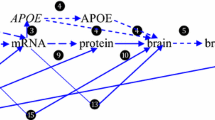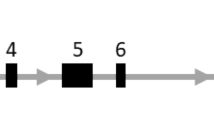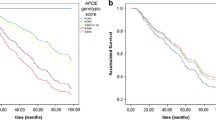Abstract
Late onset Alzheimer’s disease (LOAD) is the most common type of dementia and is characterized by impaired cholesterol homeostasis. Genome-wide association studies (GWAS) have shown that APOE, TOMM40, CLU, SORL1, PICALM, and BIN1 are related to cholesterol metabolism. To characterize the association between single-nucleotide polymorphisms (SNPs) and LOAD, we sequenced the SNP regions of the identified genes in a total of 11 LOAD cases and 12 healthy case controls in the Korean population. The SNP data showed a relatively high frequency in LOAD samples compared to the control samples. LOAD samples showed an average of 2.9 SNPs, whereas normal controls showed an average of 1.5 SNPs in the genes. Taken together, six genes associated with cholesterol metabolism using SNP analysis have shown frequent genetic variations in LOAD.

Similar content being viewed by others
References
Association AP (2000) Diagnostic and statistical manual of mental disorders DSM-IV-TR (text revision), 4th edn. American Psychiatric Pub
Barral S, Bird T, Goate A, Farlow MR, Diaz-Arrastia R, Bennett D, Graff-Radford N, Boeve BF, Sweet R, Stern Y (2012) Genotype patterns at PICALM, CR1, BIN1, CLU, and APOE genes are associated with episodic memory. Neurology 78:1464–1471
Bekris LM, Millard SP, Galloway NM, Vuletic S, Albers JJ, Li G, Galasko DR, DeCarli C, Farlow MR, Clark CM (2008) Multiple SNPs within and surrounding the apolipoprotein E gene influence cerebrospinal fluid apolipoprotein E protein levels. J Alzheimers Dis 13:255–266
Bertram L, McQueen MB, Mullin K, Blacker D, Tanzi RE (2007) Systematic meta-analyses of Alzheimer disease genetic association studies: the AlzGene database. Nat Genet 39:17–23
Bertram L, Lange C, Mullin K, Parkinson M, Hsiao M, Hogan MF, Schjeide BM, Hooli B, DiVito J, Ionita I (2008) Genome-wide association analysis reveals putative Alzheimer’s disease susceptibility loci in addition to APOE. Am J Hum Genet 83:623–632
Björkhem I, Meaney S (2004) Brain cholesterol: long secret life behind a barrier. Arterioscler Thromb Vasc Biol 24:806–815
Calero M, Tokuda T, Rostagno A, Kumar A, Zlokovic B, Frangione B, Ghiso J (1999) Functional and structural properties of lipid-associated apolipoprotein J (clusterin). Biochem J 344:375–383
Chartier-Hariln M-C, Parfitt M, Legrain S, Pérez-Tur J, Brousseau T, Evans A, Berr C, Vldal O, Roques P, Gourlet V (1994) Apolipoprotein E, ɛ4 allele as a major risk factor for sporadic early and late-onset forms of Alzheimer’s disease: analysis of the 19q13. 2 chromosomal region. Hum Mol Genet 3:569–574
Chauhan G, Adams HH, Bis JC, Weinstein G, Yu L, Töglhofer AM, Smith AV, Van Der Lee SJ, Gottesman RF, Thomson R (2015) Association of Alzheimer’s disease GWAS loci with MRI markers of brain aging. Neurobiol Aging 36:1765, e1767–e1765, e1716
Chen LH, Kao PYP, Fan YH, Ho DTY, Chan CSY, Yik PY, Ha JCT, Chu LW, Song Y-Q (2012) Polymorphisms of CR1, CLU and PICALM confer susceptibility of Alzheimer’s disease in a southern Chinese population. Neurobiol Aging 33:210, e211–e210, e217
Chung SJ, Lee J-H, Kim SY, You S, Kim MJ, Lee J-Y, Koh J (2013) Association of GWAS top hits with late-onset Alzheimer disease in Korean population. Alzheimer Dis Assoc Disord 27:250–257
Combarros O, Zelenika D, Bullido M, Tavernier B, Letenneur L, Bettens K, Berr C, Pasquier F, Fievet N, Barberger-Gateau P (2009) Genome-wide association study identifies variants at CLU and CR1 associated with Alzheimers disease. Nat Genet 41:1088–1093
Deane R, Sagare A, Hamm K, Parisi M, Lane S, Finn MB, Holtzman DM, Zlokovic BV (2008) ApoE isoform–specific disruption of amyloid β peptide clearance from mouse brain. J Clin Invest 118:4002–4013
Deelen J, Beekman M, Uh HW, Helmer Q, Kuningas M, Christiansen L, Kremer D, van der Breggen R, Suchiman HED, Lakenberg N (2011) Genome-wide association study identifies a single major locus contributing to survival into old age; the APOE locus revisited. Aging Cell 10:686–698
Dietschy JM, Turley SD (2004) Thematic review series: brain lipids. Cholesterol metabolism in the central nervous system during early development and in the mature animal. J Lipid Res 45:1375–1397
Farrer LA, Cupples LA, Haines JL, Hyman B, Kukull WA, Mayeux R, Myers RH, Pericak-Vance MA, Risch N, Van Duijn CM (1997) Effects of age, sex, and ethnicity on the association between apolipoprotein E genotype and Alzheimer disease: a meta-analysis. JAMA 278:1349–1356
Giri M, Zhang M, Lü Y (2016) Genes associated with Alzheimer’s disease: an overview and current status. Clin Interv Aging 11:665
Harold D, Abraham R, Hollingworth P, Sims R, Gerrish A, Hamshere ML, Pahwa JS, Moskvina V, Dowzell K, Williams A (2009) Genome-wide association study identifies variants at CLU and PICALM associated with Alzheimer’s disease. Nat Genet 41:1088–1093
Jones R, Wilkinson D, Lopez OL, Cummings J, Waldemar G, Zhang R, Mackell J, Gauthier S (2011) Collaborative research between academia and industry using a large clinical trial database: a case study in Alzheimer’s disease. Trials 12:1
Kim DH, Gim J-A, Yeo SH, Kim H-S (2016) Integrated late onset Alzheimer’s disease (LOAD) susceptibility genes: cholesterol metabolism and trafficking perspectives. Gene 597:10–16
Kim DH, Gim J-A, Yoon D, Kim S, Kim H-S (2017) Metabolomics and mitochondrial dysfunction in Alzheimer’s disease. Genes Genom. doi:10.1007/s13258-016-0494-3
Kukull WA, Schellenberg GD, Bowen JD, McCormick WC, Yu C-E, Teri L, Thompson JD, O’Meara ES, Larson EB (1996) Apolipoprotein E in Alzheimer’s disease risk and case detection: a case-control study. J Clin Epidemiol 49:1143–1148
Lambert J, Mann D, Richard F, Tian J, Shi J, Thaker U, Merrot S, Harris J, Frigard B, Iwatsubo T (2005) Is there a relation between APOE expression and brain amyloid load in Alzheimer’s disease? J Neurol Neurosurg Psychiatry 76:928–933
Lambert J-C, Ibrahim-Verbaas CA, Harold D, Naj AC, Sims R, Bellenguez C, Jun G, DeStefano AL, Bis JC, Beecham GW (2013) Meta-analysis of 74,046 individuals identifies 11 new susceptibility loci for Alzheimer’s disease. Nat Genet 45:1452–1458
Lee JH, Cheng R, Schupf N, Manly J, Lantigua R, Stern Y, Rogaeva E, Wakutani Y, Farrer L, George-Hyslop PS (2007) The association between genetic variants in SORL1 and Alzheimer disease in an urban, multiethnic, community-based cohort. Arch Neurol 64:501–506
Liu C-C, Kanekiyo T, Xu H, Bu G (2013) Apolipoprotein E and Alzheimer disease: risk, mechanisms and therapy. Nat Rev Neurol 9:106–118
Morgen K, Ramirez A, Frölich L, Tost H, Plichta MM, Kölsch H, Rakebrandt F, Rienhoff O, Jessen F, Peters O (2014) Genetic interaction of PICALM and APOE is associated with brain atrophy and cognitive impairment in Alzheimer’s disease. Alzheimers Dement 10:S269–S276
Naj AC, Jun G, Beecham GW, Wang L-S, Vardarajan BN, Buros J, Gallins PJ, Buxbaum JD, Jarvik GP, Crane PK (2011) Common variants at MS4A4/MS4A6E, CD2AP, CD33 and EPHA1 are associated with late-onset Alzheimer’s disease. Nat Genet 43:436–441
Pant S, Sharma M, Patel K, Caplan S, Carr CM, Grant BD (2009) AMPH-1/Amphiphysin/Bin1 functions with RME-1/Ehd1 in endocytic recycling. Nat Cell Biol 11:1399–1410
Pfrieger FW (2003) Role of cholesterol in synapse formation and function. BBA Biomembr 1610:271–280
Raj T, Shulman JM, Keenan BT, Chibnik LB, Evans DA, Bennett DA, Stranger BE, De Jager PL (2012) Alzheimer disease susceptibility loci: evidence for a protein network under natural selection. Am J Hum Genet 90:720–726
Roberts KF, Elbert DL, Kasten TP, Patterson BW, Sigurdson WC, Connors RE, Ovod V, Munsell LY, Mawuenyega KG, Miller-Thomas MM (2014) Amyloid-β efflux from the central nervous system into the plasma. Ann Neurol 76:837–844
Rogaeva E, Meng Y, Lee JH, Gu Y, Kawarai T, Zou F, Katayama T, Baldwin CT, Cheng R, Hasegawa H (2007) The neuronal sortilin-related receptor SORL1 is genetically associated with Alzheimer disease. Nat Genet 39:168–177
Ronald J, Rajagopalan R, Ranchalis JE, Marshall JK, Hatsukami TS, Heagerty PJ, Jarvik GP (2009) Analysis of recently identified dyslipidemia alleles reveals two loci that contribute to risk for carotid artery disease. Lipids Health Dis 8:1
St Clair D, Rennie M, Slorach E, Norrman J, Yates C, Carothers A (1995) Apolipoprotein E epsilon 4 allele is a risk factor for familial and sporadic presenile Alzheimer’s disease in both homozygote and heterozygote carriers. J Med Genet 32:642–644
Szymanski M, Wang R, Bassett SS, Avramopoulos D (2011) Alzheimer’s risk variants in the clusterin gene are associated with alternative splicing. Transl Psychiatry 1:e18
Talwar P, Silla Y, Grover S, Gupta M, Agarwal R, Kushwaha S, Kukreti R (2014) Genomic convergence and network analysis approach to identify candidate genes in Alzheimer’s disease. BMC Genom 15:1
Tan M-S, Yu J-T, Tan L (2013) Bridging integrator 1 (BIN1): form, function, and Alzheimer’s disease. Trends Mol Med 19:594–603
van Duijn CM, de Knijff P, Wehnert A, De Voecht J, Bronzova JB, Havekes LM, Hofman A, van Broeckhoven C (1995) The apolipoprotein E ε2 allele is associated with an increased risk of early-onset alzheimer’s disease and a reduced survival. Ann Neurol 37:605–610
Van Cauwenberghe C, Van Broeckhoven C, Sleegers K (2015) The genetic landscape of Alzheimer disease: clinical implications and perspectives. Genet Med 18:421–430
Wang Z, Lei H, Zheng M, Li Y, Cui Y, Hao F (2016) Meta-analysis of the association between Alzheimer disease and variants in GAB2, PICALM, and SORL1. Mol Neurobiol 53:6501–6510
Weisgraber KH (1990) Apolipoprotein E distribution among human plasma lipoproteins: role of the cysteine-arginine interchange at residue 112. J Lipid Res 31:1503–1511
Xing Y-Y, Yu J-T, Cui W-Z, Zhong X-L, Wu Z-C, Zhang Q, Tan L (2012) Blood clusterin levels, rs9331888 polymorphism, and the risk of Alzheimer’s disease. J Alzheimers Dis 29:515–519
Yang X, Li J, Liu B, Li Y, Jiang T (2016) Impact of PICALM and CLU on hippocampal degeneration. Hum Brain Mapp 37:2419–2430
Yoshizawa T, Yamakawa-Kobayashi K, Komatsuzaki Y, Arinami T, Oguni Ei, Mizusawa H, Shoji Si, Hamaguchi H (1994) Dose-dependent association of apolipoprotein e allele ε4 with late-onset, sporadic Alzheimer’s disease. Ann Neurol 36:656–659
Zhao Z, Sagare AP, Ma Q, Halliday MR, Kong P, Kisler K, Winkler EA, Ramanathan A, Kanekiyo T, Bu G (2015) Central role for PICALM in amyloid-[beta] blood–brain barrier transcytosis and clearance. Nat Neurosci 18:978–987
Author information
Authors and Affiliations
Corresponding author
Ethics declarations
Conflict of interest
DHK that he has no conflict of interest. J-AG that he has no conflict of interest. AM that he has no conflict of interest. KL that he has no conflict of interest. YC that he has no conflict of interest. H-SK that he has no conflict of interest.
Ethical approval
This study was performed in accordance with South Korean laws and the guidelines of the Ethics Committee at the Woosan Medical Foundation.
Additional information
Dong Hee Kim, Jeong-An Gim and Anshuman Mishra have contributed equally to this work.
Rights and permissions
About this article
Cite this article
Kim, D.H., Gim, JA., Mishra, A. et al. SNP analysis of genes related to cholesterol metabolism and associated with late-onset Alzheimer’s disease. Genes Genom 39, 593–600 (2017). https://doi.org/10.1007/s13258-017-0524-9
Received:
Accepted:
Published:
Issue Date:
DOI: https://doi.org/10.1007/s13258-017-0524-9




